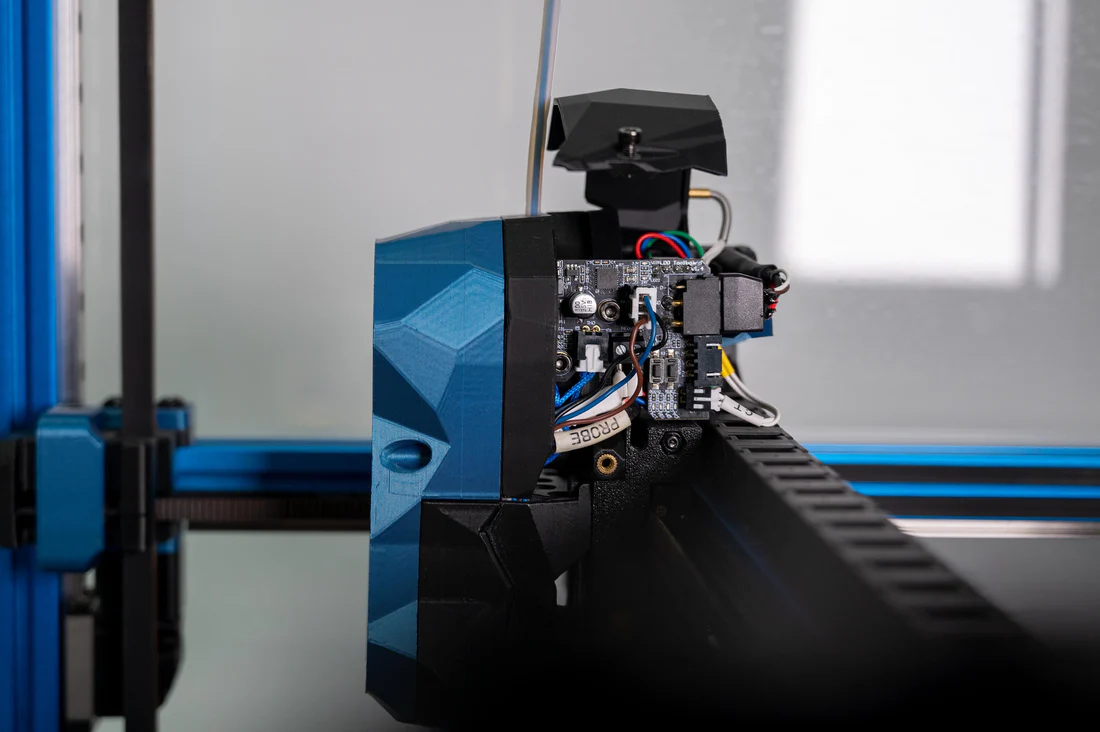Introduction
The LDO Voron Trident is a high-performance 3D printer designed for precision, speed, and reliability. Based on the open-source Voron Trident design, this version is meticulously curated by LDO Motors, a company renowned for its high-quality motion components. The LDO Voron Trident offers a pre-configured, easy-to-build kit with premium parts, making it an excellent choice for both enthusiasts and professionals seeking a top-tier CoreXY machine.
In this article, we’ll explore:
- The Voron Trident’s design philosophy
- Key features of the LDO version
- Build process and assembly considerations
- Performance and print quality
- Comparison with other Voron models
- Who should consider buying it?
1. Voron Trident Design Philosophy
The Voron Trident is one of the flagship models in the Voron Design lineup, known for its CoreXY motion system, fixed gantry, and moving bed. Unlike the Voron 2.4 (which uses a flying gantry with quad Z motors), the Trident features a stationary gantry and three independently controlled Z motors for bed leveling. This design offers several advantages:
- Improved stability (no moving gantry means less vibration)
- Faster print speeds (CoreXY kinematics allow rapid movement)
- Auto bed leveling with three-point Z-tilt adjustment
- Compact footprint compared to dual-Z printers
The LDO Voron Trident takes this foundation and enhances it with premium components, ensuring smoother assembly and better performance.
2. Key Features of the LDO Voron Trident
LDO Motors is known for its high-quality stepper motors, linear rails, and precision-machined parts. The LDO Voron Trident kit includes:
A. Premium Motion Components
- LDO High-Torque Stepper Motors – Smooth and quiet operation
- Precision Linear Rails – For accurate and repeatable motion
- Gates Belts & Pulleys – Reduced backlash and improved durability
B. Enhanced Frame & Structure
- Black-anodized aluminum extrusions – Sturdy and corrosion-resistant
- Pre-cut and pre-tapped panels – Simplifies assembly
- Magnetic panels – Easy access for maintenance
C. Advanced Electronics & Heating
- LDO PCB Kit – Neat wiring with custom breakout boards
- Raspberry Pi compatibility (for Klipper firmware)
- High-wattage heater & thermistor – Fast and stable heating
D. Optional Upgrades
- CAN bus toolhead (for reduced wiring)
- LED lighting kits
- Different build plate options (PEI, textured, etc.)
3. Build Process & Assembly Considerations
One of the biggest advantages of the LDO Voron Trident is its well-documented and streamlined assembly process. Unlike sourcing parts individually, the LDO kit ensures compatibility and reduces frustration.
A. Step-by-Step Assembly Overview
- Frame Construction – Bolt together aluminum extrusions.
- Motion System – Install linear rails, belts, and pulleys.
- Z-Axis Assembly – Mount the three Z motors and lead screws.
- Bed Assembly – Attach the heated bed with kinematic mounts.
- Gantry & Toolhead – Assemble the X/Y carriage and hotend.
- Electronics Wiring – Connect motors, heaters, and sensors.
- Firmware Setup – Flash Klipper and configure settings.
B. Tips for a Successful Build
- Follow the official Voron manual (LDO provides additional guidance).
- Check belt tension to avoid layer shifts.
- Ensure proper Z-offset calibration for first-layer adhesion.
- Use high-quality thermal paste for the heatbed.
4. Performance & Print Quality
Once assembled, the LDO Voron Trident delivers exceptional print quality thanks to its rigid frame and precise motion system.
A. Speed & Acceleration
- Capable of 150+ mm/s print speeds (with proper tuning).
- CoreXY kinematics reduce moving mass, allowing faster acceleration.
B. Print Quality & Precision
- Excellent dimensional accuracy due to linear rails.
- Minimal ghosting/ringing (if input shaping is configured).
- Great for ABS, PETG, and PLA (enclosed printing recommended for ABS).
C. Noise Levels
- Quieter than many DIY printers (especially with silent stepper drivers).
5. Comparison with Other Voron Models
| Feature | Voron Trident | Voron 2.4 | Voron V0 |
|---|---|---|---|
| Gantry Type | Fixed gantry | Flying gantry | Fixed gantry |
| Z-Axis | 3-point leveling | 4-point leveling | Single Z |
| Build Volume | 250x250x250mm (typical) | 350x350x350mm (max) | 120x120x120mm |
| Best For | Balanced speed & stability | Large builds | Compact & portable |
Why choose the Trident over the 2.4?
- Simpler Z-axis mechanism (fewer motors to tune).
- More rigid frame (since the gantry doesn’t move).
- Lower cost (compared to a 2.4 with similar specs).
6. Who Should Buy the LDO Voron Trident?
This printer is ideal for:
✅ Enthusiasts who want a high-end DIY experience
✅ Professionals needing reliability and speed
✅ ABS/ASA users (thanks to enclosed design)
✅ Those who prefer a pre-sourced kit over self-sourcing
However, it may not be the best choice for:
❌ Complete beginners (requires some technical skill)
❌ Users who need ultra-large build volumes (consider a 2.4 instead)
Conclusion
The LDO Voron Trident is one of the best high-performance 3D printer kits available today. With premium components, a rigid CoreXY design, and excellent print quality, it stands out as a top choice for serious makers. While the assembly requires some technical skill, the LDO kit simplifies the process with high-quality parts and documentation.
If you’re looking for a fast, precise, and reliable 3D printer that can handle engineering-grade filaments, the LDO Voron Trident is an outstanding investment.
